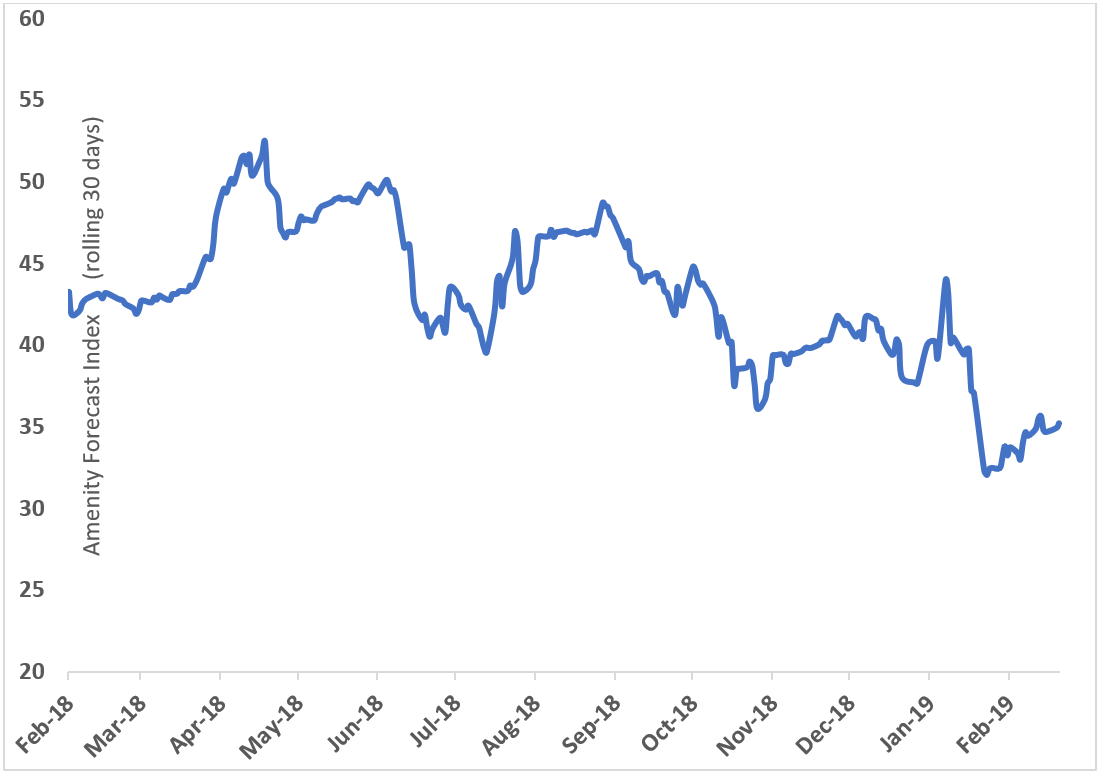We updated the proprietary Amenity Forecast Index for recent corporate earnings using our text analytics platform to identify the key themes driving the Index.
About the Index: Earnings sentiment of only forward-looking commentary from U.S. quarterly earnings calls. This analysis goes beyond the stated revenue and EPS guidance to capture all significant forward-looking financial commentary: market share, new products,pricing, inflation, margins, growth, Capex, hiring, share repurchase, etc.
We highlight 3 key takeaways:
- The Amenity Forecast Index has continued its slow upward grind from January lows, assisted by a dovish Fed, and China trade hopes. The index remains nearly 20% lower than the same point a year ago.
- Europe has joined China at the forefront of global growth concerns.
- Companies are expecting less margin pressure from raw material inflation than in 2018.
1. Amenity Forecast Index grinding slightly higher from the January lows
The latest Index reading of 35.2 compares to 33.7 at the beginning of the month, but remains well below 42.8 at this time last year. The Amenity Forecast Index is measured on a scale of -100 to +100 on a rolling 30-day basis.
The chart below shows the Index was firmly in positive territory throughout 2018 before catching a wave of caution through the first two weeks of Q4 earnings. Since the January low point, the Fed has turned more dovish and sentiment toward U.S. – China trade has turned more optimistic. Themes gaining prominence recently include weakness in Europe and less margin pressure from raw material inflation:

2. Europe joins China at the forefront of global growth concerns
The Eurozone PMI recently dipped into contractionary territory, but we doubt many multi-national CEOs were surprised by the number:
Nordson Corporation (2/21/19):
- “I would say it kind of lines up with the economy in terms of just a slower growth year. I mean, you see it in Germany, you see it in France, it’s going to be a slower growth year. We’ll see if Brexit has any particular impact. We don’t expect it to have a big impact for us. But I think, in general,it’s affecting the economies.”
Genuine Parts Company (2/19/19):
- “Our guidance reflects the cautiously optimistic outlook for 2019. We are being cautious due to the potential for an economic slowdown, and in particular, a slowing industrial economy in the second half of the year. In addition, we expect to see a more challenging sales environment in Europe in 2019.”
Ecolab (2/19/19):
- “…the U.S. is forecasted to grow slower, but we’re not that GDP-sensitive. We still think it’s going to be a very solid economy. And our ability to go capture share and do things and offset lost business, et cetera, we think, remains pretty robust in the U.S. Europe is going to be a tougher environment,we think, probably where you see weaker economies maybe show up.”
Neenah, Inc. (2/12/19):
- “I mentioned in early November that we were starting to sense more uncertainty in global demand. This ultimately contributed to lower shipments and inventory destocking by customers in the fourth quarter. Economies in Western Europe and Asia have slowed.”
BorgWarner (2/14/19):
- “We expect that the challenging conditions in China and Europe will continue into 2019.”
3. Moderating raw material pressures fuel some optimism on margins
A number of inflationary pressures impacted margins in 2018 including freight, raw materials, and labor. On the raw materials front, companies are pointing to more balanced price-cost dynamics in 2019:
Valmont Industries (2/21/19):
- “We expect a 20 to 50 basis point improvement in operating margins with average raw material cost, including grade,expected to be relatively flat in the aggregate to slightly deflationary in 2019 as compared with 2018.”
JELD-WEN holding (2/19/19):
- “So what I would say is, we do expect price-cost tailwind for ’19. We’ve taken price actions here at the end of the year and into the early part of this year that would more than offset what we expect to see in inflation.”
Masonite International (2/19/19):
- “We’re expecting about a 3% increase in commodity inflation in 2019. And we would expect some inflationary pressures to continue through the balance of that long-term growth framework horizon. Now we are seeing material cost begin to moderate a little bit as we get into ‘20 and ‘21.”
Cooper Tire & Rubber ( 2/19/19):
- “Raw material costs appeared to have stabilized. Therefore, we expect our first quarter 2019 raw material index to be down nearly 3% sequentially, but up nearly 3%year-over-year.”
Tempur Sealy (2/14/19):
- “After 2 years of material commodity cost headwinds, we do not currently expect commodity cost inflation in 2019.”
Dana Incorporated (2/15/19):
- “…we expect commodity inflation to continue this year, albeit with a high recovery rate of about $90 million and a net profit headwind of about $40 million as commodity costs level out. This continues to put pressure on our profit margin expansion, but we are beginning to see signs that commodity costs will improve as we move through the year.”
Bloomin’ Brands (2/14/19):
- “Commodities are expected to be up approximately 2% in 2019, as compared to approximately 3% in 2018.”
Join the Amenity Viewer Beta Program today to analyze earnings call transcriptions and enable you to spot outliers, identify critical insights, and understand key drivers.
This communication does not represent investment advice. Transcript text provided by S&P Global Market Intelligence.
Copyright ©2019.
